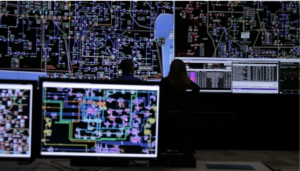New year, new MISO? Renewables developers hope for progress in 2024


MISO control room (Courtesy: MISO)
Renewable energy developers were on the losing end of several critical decisions by the Federal Energy Regulatory Commission (FERC), in favor of MISO, the Midwest grid operator, last year. I hope that 2024 will produce more favorable results for the clean energy industry.
Capacity accreditation is sure to be a critical issue for developers participating in MISO. If FERC approves the current proposal put forth by the grid operator, solar capacity will plummet in the next decade.
Last year was a doozy for Midwest developers. The reactive power compensation proposal from MISO transmission owners, as well as the seasonal capacity market plan, were approved by FERC without unanimous commissioner approval, opening a door for appeal. In another unfortunate move, MISO reduced the distribution factor for ERIS studies without the need for FERC approval.
Now, the question for the upcoming queue megawatt cap proposal is, can renewable developers start 2024 with a win? Before answering, we should first look back at a troublesome 2023.
MISO received approval from FERC on the reactive power filing
Last year, without much notice, MISO transmission owners filed a proposal at FERC to stop compensating renewable developers for reactive power, and FERC accepted despite objections from multiple parties, including the Solar Industries Energy Association (SEIA). Commissioner Danley dissented in this proposal, but his term has expired.
FERC rejected a rehearing request, and as a result, there is an open docket at the United States Court of Appeals for the District of Columbia Circuit. I am curious if the court rules in favor of FERC or the renewable developers. If the former, transmission owners, not only at MISO but also in other regional markets, will be emboldened to stop compensating developers for other ancillary services.
If revenues from ancillary services are nil, and MISO’s capacity reforms indicate zero capacity credit for solar (if FERC approves), the renewable industry can only on energy market prices, which are not significant. That’s why the reactive power court case is so important for the renewables industry.
MISO received FERC approval on the seasonal capacity market
Before delving into the new capacity accreditation issue for renewables that MISO plans to file with FERC in mid-2024, it is worth noting that MISO received approval on its seasonal capacity market proposal. Commissioner Clements wrote an 11-page dissent, which focused on different tracks for Schedule 53 resources and non-Schedule 53 resources. Schedule 53 resources are resources with this new seasonal capacity accreditation rule.
With the new capacity accreditation, MISO proposes to move all existing resources to the Schedule 53 resources concept.
Moving onto the new method called the Direct – Loss of Load (D-LOL) method. MISO is still facing many stakeholder concerns, specifically from the renewable developers, because, under this new D-LOL method, solar will get 0% capacity credit in 10 years. Currently, MISO gives 50% capacity credit to solar in all seasons except winter, when it is 0%.
While MISO is not taking formal steps to delay coal retirements, more than 3,500 MW of coal delayed retirement due to 2022 capacity market prices. Hence, a 0% capacity credit for solar in the future, and coal plant retirement delays, indicate that unless the renewables industry puts up a fight, MISO will get a free pass to continue what it is doing, which is encouraging fossil fuels. States like Minnesota and Michigan, which passed 100% clean energy by 2040, will have a hard time digesting that outcome and will likely question their utility membership at MISO. On the other hand, states like North Dakota and Indiana benefit from this potential outcome.
MISO gets its way with the distribution factor proposal
MISO didn’t need FERC’s approval to decrease a Distribution Factor (DFAX) percentage from 20% to 10% in 2022. This DFAX reduction results in increasing the chances for renewable developers to pay for network upgrades even though developers are choosing a non-firm Energy Resource Interconnection Service (ERIS). The MISO state regulatory association, the Organization of MISO States (OMS), also supported the MISO proposal because it was concerned about transmission congestion. MISO’s top planning committee – the Planning Advisory Committee approved this MISO proposal in early 2023.
But since the 2023 Queue window was closed, developers have yet to see the economic pinch from MISO studies under this new DFAX proposal. If FERC approves MISO’s interconnection queue proposal early this year, and MISO accepts new projects, the earliest MISO will post initial results is expected to be September 2025 or later based on past queue cycle history. For example, MISO expects to release the DPP Phase 1 study results in March 2024 for projects submitted in the Sep 2022 queue window cycle.
Will FERC accept MISO’s queue cap proposal?
All these FERC approvals for MISO’s proposals in 2023 indicate FERC is going to accept once again MISO’s efforts to reform its queue in 2024. But the question remains: what happens to MISO’s proposal to limit the queue by a MW cap? Would FERC deem it anti-competitive?
MISO wants to limit the queue to a certain MW size per region to limit its queue backlog. MISO wants to eliminate what happened with the 2022 queue when it received a record number of requests. But if renewable developers can’t file interconnection requests as they see fit, isn’t it uneconomic for the RTO?
Since FERC has already eliminated reactive power payments and limited capacity payments (most likely due to the new capacity accreditation), would FERC side with MISO once again and accept MISO’s queue proposal? If FERC does that, developers will once again knock on the doors of the Court of Appeals.
The year 2024 could be an interesting year for renewable developers at MISO.



